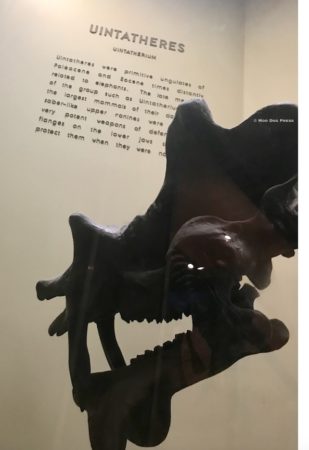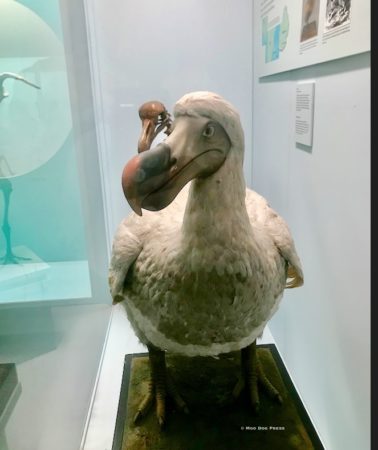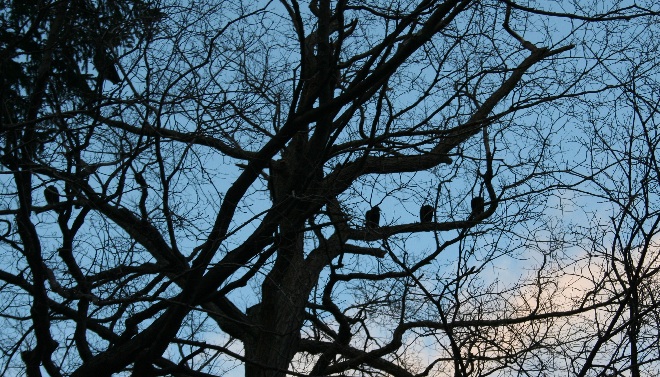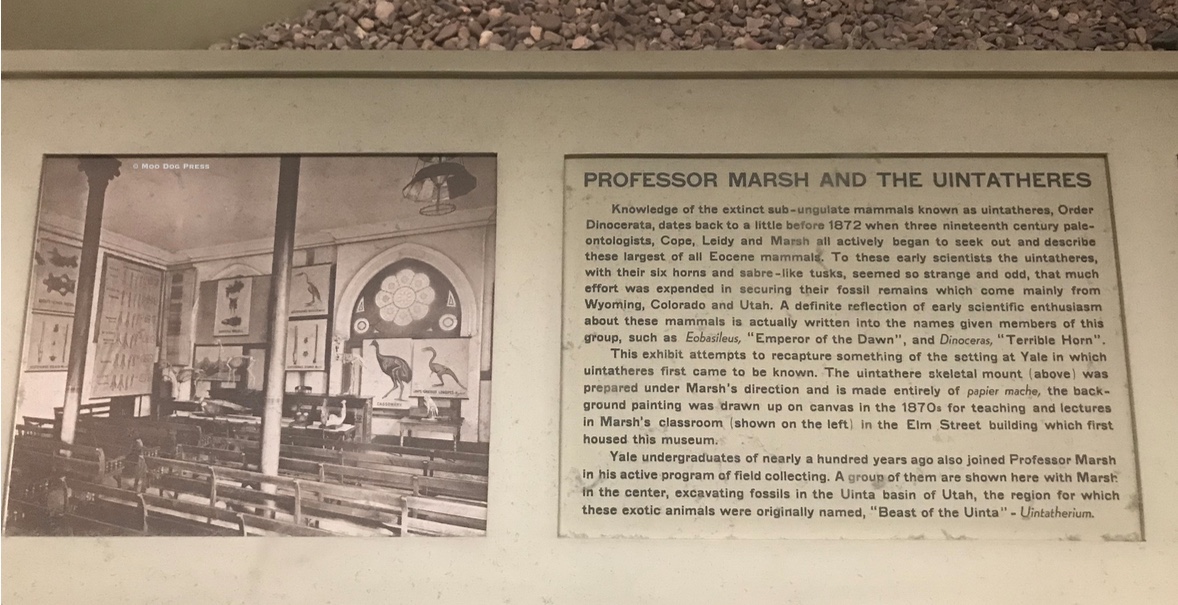Dodo at Yale Peabody, A “Fine Persian Rug’ Then Add To Annual Bird Count
“The whole of life lies in the verb seeing.” — Teilhard De Chardin
Don't need nor want more stuff. (Well, excepting books.) Do want to contribute, support, help and not do further harm to the planet.

Uintatheres, “primitive ungulates…distantly related to elephants.” See below for the accompanying description of this exhibit.”

What did a dodo sound like? No one will ever know. This dodo with feathers exhibit and the extinct bird skeleton behind it are part of the wonders at Yale Peabody Museum of Natural History in New Haven, Connecticut. MDP photo
Worth repeating since a visit on April 6, 2019: The Peabody Museum of Natural History in New Haven, Connecticut, will close the Great Hall and Mammal Hall for renovations Jan. 1, 2020 (see below). For those who haven't visited in awhile or ever — December is a great time to refresh memories or make new ones. The diversity of life past and present make for great conversations. Study up on the lesson of the forever extinct dodo, grab a copy of The Song of the Dodo by David Quammen and read passages aloud to weave together current events and climate science awareness. If nothing else, think on this excerpt, the opening paragraph to the book.
“Let's start indoors. Let's start by imagining a fine Persian carpet and a hunting knife. The carpet is 12 feet by 18, say. That gives us 216 square feet of continuous woven material. Is the knife razor-sharp? If not, we hone it. We set about cutting the carpet into 36 equal pieces, each one a rectangle, two feet by three. Never mind the hardwood floor. The severing fibers release small tweaky noises, like the muted yelps of outraged Persian weavers. Never mind the weavers. When we're finished cutting, we measure the individual pieces, total them up — and find that, lo, there's still 216 square feet of recognizably carpetlike stuff. But what does it amount to? Have we got 36 nice Persian throw rugs? No. All we're left with is three dozen ragged fragments, each on worthless and commencing to come apart.
“Now take the same logic outdoors…”
After a visit to preserved life forms from our amazing planet, consider participating in Audubon's 120th Christmas Bird Count, Saturday, Dec. 14, 2019 through Sunday, Jan. 5, 2020.
The Christmas Bird Count (CBC) is a long-standing program of the National Audubon Society, with more than 100 years of community science involvement. It is an early-winter bird census, where thousands of volunteers across the U.S., Canada, and many countries in the Western Hemisphere go out over a 24-hour period on one calendar day to count birds. For details about how to add your efforts to the count, see www.audubon.org/conservation/join-christmas-bird-count.
 Pay attention. Everything humans make deteriorates. Everything in the natural world changes and renews. Life is born, grows, matures, then dies (if lucky enough, reproduces). In time, new growth arises from the remains.
Pay attention. Everything humans make deteriorates. Everything in the natural world changes and renews. Life is born, grows, matures, then dies (if lucky enough, reproduces). In time, new growth arises from the remains.
Those three bumps on a branch in the photo above? Turkey vultures – and there were more than a dozen when this image was captured.
A turkey vulture suns its outspread wings overhead in a tall maple tree, where only days before more than a dozen had perched in the same branches. (Why the vulture suns those wings, sheds light on how it feeds, an interesting bit of information, linked here with photos.) A stone's throw away, a blue heron hunts along the banks of the Coginchaug River that wends somewhat parallel to busy Route 66 through Middletown. The long-legged bird freezes as a walker passes by utterly unaware. A red-tailed hawk flaps off, disturbed from its perch nearby.
The 120th annual National Audubon Society Christmas Bird Count 2019-2020 from Connecticut Ornithological Association (for full details consult the PDF online):
Saturday, Dec. 14: New Haven, CT (CTNH) Compiler: Chris Loscalzo, Woodbridge; (203) 389-6508 (New Haven Bird Club).
Storrs, CT (CTST) Compiler: Steve Morytko, Ashford; (M) (860) 680-5728, (Natchaug Ornithological Society).
Woodbury-Roxbury, CT (CTWR) Compiler: Ken Elkins, Audubon Center at Bent of the River, Southbury; (203)405-9113, (Western Connecticut Bird Club).
Sunday, Dec. 15: Greenwich-Stamford, CT (CTGS) Compiler: Cynthia Ehlinger, Riverside; (203) 219-1963, (Audubon Greenwich).
Hartford, CT (CTHA) Compiler: Jay Kaplan, Canton; (860) 693-0263 (days), (860) 693-0157 (evenings), (Hartford Audubon Society).
Litchfield Hills, CT (CTLH) Compiler: Raymond E. Belding, Torrington; (860) 482-4046, (Litchfield Hills Audubon Society).
Lakeville-Sharon (Trixie Strauss CBC), Compiler: Zachary Adams, Sharon Audubon Center/National Audubon Society; (860) 364-0520 or (717) 926-3926.
Oxford, CT (CTOX) Compiler: Roy Harvey, Beacon Falls; (203)651-9818 (cell)
Quinnipiac Valley (CTQV) Compilers: Melissa Baston, (860) 995-0656 and Corrie Folsom-O’Keefe, (203) 233-0535, (Quinnipiac Valley Audubon Society)
Salmon River, CT (CTSR) Compilers: Sharon Dellinger, Colchester; (860) 803-1626, and Doreen Jezek, East Haddam (859) 492-1656 (Mattabeseck Audubon Society).
Westport (CTWE) Compilers: Mardi and Townsend Dickinson, Norwalk; (203) 846-0359; Kymry Group (Connecticut Audubon Society Birdcraft Sanctuary).
Saturday, Dec. 21: Barkhamsted (CTBA) Compiler: David Tripp, Jr., Torrington; (Litchfield Hills Audubon Society)
Stratford-Milford, CT (CTSM) Compiler: Steve Mayo, Bethany; (203) 551-1707.
Sunday, Dec. 22: Napatree, RI-CT-NY (RINT) Compilers: Shai Mitra, Biology Department, College of Staten Island, and Glenn Williams, Mystic.
Saturday, Dec. 28: Bristol, CTBR Compiler: Jack Swatt, Wolcott; (203) 592-4686.
Sunday, Dec. 29: Edwin Way Teale, Trail Wood Sanctuary, Hampton, CT (CTEW) Compiler: Sue Harrington, Storrs; (860) 429-6257 (Natchaug Ornithological Society).
Wednesday, Jan. 1, 2020: Pawling (Hidden Valley), NY/CT (NYHV) Compilers: Carena Pooth and Angela Dimmitt, Sherman; (860) 355-3429 (Ralph T. Waterman Bird Club). Snow date is Thursday, Jan. 2.
Saturday, Jan. 4: Guilford-Long Island Sound, CTGL Compiler: Robert Kuchta, (Menunkatuck Audubon Society).
New London, CT (CTNL) Compiler: Robert Dewire, Pawcatuck, (860) 599-3085.
Sunday, Jan. 5: Old Lyme-Saybrook, CT (CTOL) Compiler: Barbara Hawes, Waterford; (860) 710-5811.
To see a sleepy screech owl right in front of my face while out on a ride took someone else pointing it out. The bundle of feathers literally was within arm's reach as the perfectly camouflaged owl perched at the intersection of a branch and tree. Eye level while on horseback.
So how well do you see life? Hunters and artists may see life more sharply because they are more aware. To track your quarry takes knowledge – how a species lives, feeds, moves about and marks its territory. Artists open up their eyes (and souls) to see, record and share what nearly all others miss – the fine detail, a fresh perspective. Sometimes the artist and the hunter are one and the same – as was John James Audubon, the French-American ornithologist, naturalist, hunter, and painter, who shot his subjects, then arranged them to paint his observations. What seems harsh today doesn't change the past. By combining his experiences of how each species lived and learning their habitats or behavior, he broke new ground. And those who followed after and established the society named for him knew that to study life, it's necessary to understand how a creature lives. That led to protecting swaths of habitats, gaining ground as birds migrate and do not see human-made borders, lines, properties. Today the National Audubon Society “protects birds and the places they need, today and tomorrow.”
We've come a long way, but not far enough. Earth is losing species at an accelerated pace; scientists tell us all to heed the flashing danger signs.
Or as Quammen writes (The Song of the Dodo on page 607, Scribner 1996): “Yes, Simberloff predicts, the current cataclysm of extinctions is indeed likely to stand among the worst half-dozen such events in the history of life on Earth.
“This time around we're the Death Star.”
Excerpt from Yale Alumni Magazine story by Mark Alden Branch (Jan/Feb 2019): “Edward Bass ’67, who has made several major gifts to Yale, has donated $160 million toward the project—the largest known gift to a museum of natural history, according to the university. Yale won’t release the total cost of the project, but Skelly says they’ve still got another $20 million to raise. The precise schedule for the project has not been determined, though it will likely involve the museum’s closing for at least two years. It will remain open into 2020.
“At the heart of the redesigned museum will be a new three-story central space that connects the exhibit galleries, improves circulation, and provides ‘a place to take a break,' in Skelly’s words. A new entrance and terrace on the north side will better connect the museum to Science Hill. And the lower level will feature a new K–12 education center, with classrooms and other facilities to better accommodate school groups and after-school programs.
“The university community will notice the change, too. Dedicated museum classrooms will allow Yale students and professors to hold classes and interact with the collections, as they do now at the Art Gallery and the Center for British Art.
“As for those dinosaurs, Skelly says they’re ‘going on holiday to Canada,' where a leading restoration firm will clean the skeletons and prepare them for reinstallation. ‘When we reopen, the poses will be much more active and truer to the science that has advanced since they were first mounted in the 1920s,' says Skelly.
“The rest of the collection will get a similar treatment. New exhibits will be designed with an eye toward greater flexibility. ‘We want not only to make the exhibitions up to date,' says Skelly, ‘but to put them on a footing where they can stay up to date.'”
From the description of the uintathere exhibit: “This exhibit attempts to recapture something of the setting at Yale in which uintatheres first came to be known. The unitathere skeletal mount (above) was prepared under Marsh’s direction and is made entirely of paper mache, the background painting was drawn up on canvas in the 1870s for teaching and lectures in Marsh’s classroom (shown on the left) in the Elm Street building which forest housed this museum.
“Yale undergraduates of nearly a hundred year ago also joined Professor Marsh in his active program of field collecting. …”
Go see it all before this chapter of the museum closes for renovations to expand and enhance the collections. While the Great Hall and Mammal Hall close for renovation Jan. 1, 2020, the rest of the galleries will be open until June 30, 2020.


